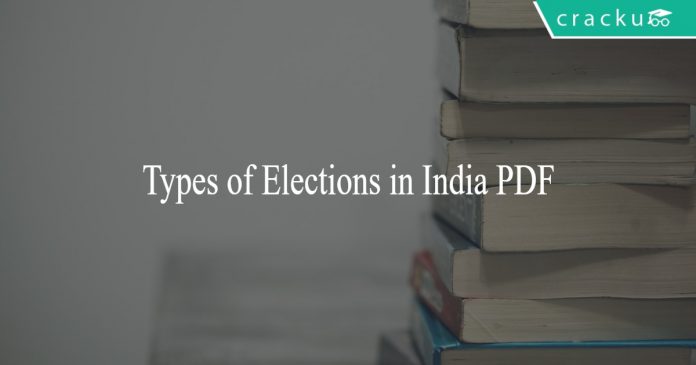Download the complete information about the Types of Elections in India useful for UPSC, SSC, Banking RPF & other competitive exams.
Download Types of Elections in India PDF
All Banking/SSC/RRB Content @ Rs. 199
Download Daily & Monthly Current affairs quiz PDF
Download all General Knowledge Questions & Answers PDF
Download Current Affairs Questions & Answers PDF
Download General Science Notes And Q&A PDF
Contents
Types of Elections in India:
Legislature:
1.General Elections:
General Elections are normally held once in every 5 years to elect the Members of Loksabha, lower house of the parliament. Maximum strength of the Loksabha is 552, upto 530 members representing states, upto 20 members representing UTs & not more than 2 members from Anglo-indian community nominated by the president if in his/her opinion the community is not adequately represented in the house. Present strength of the Loksabha is 545 members.The number of seats in the house are allocated in a way such that the ratio of number of seats allocated to each state to its total population is same for all states. Members are elected by first past the post system i.e, candidate getting highest number of votes will win the election.
2.Rajya Sabha Elections:
Rajya Sabha is the upper house of the parliament.Maximum strength of the Rajya Sabha is 250, 12 members being nominated by the president who are experts in the fields of literature, arts, science & social services.Present strength of Rajya Sabha is 245.
Every Rajya sabha MP has a tenure of 6 years & elections to one-third members are held every 2 years.The representatives of States and Union Territories in the Rajya Sabha are elected by the elected members of Legislative Assembly pertaining to each State and by the members of Electoral College for that Union Territory, respectively, through the proportional representation with the single transferable vote (STV) system.
3.Legislative Assembly Elections:
Legislative Assembly or Vidhan Sabha is the lower house of state legislature in case of bicameral while sole house in case of Unicameral .Its maximum size is not more than 500 members and not fewer than 60 members. However, the size of the State Legislative Assembly can be fewer than 59 members through an Act of Parliament such as in the states of Goa, Sikkim, Mizoram and the Union Territory of Puducherry.
Legislative assembly or Vidhan Sabha elections are held every 5 years in all the 29 states & 2 of the 7 Union Territories Delhi & Puducherry by first past the post system.
4.Legislative Council Elections:
There are about 7 states ( Andhra Pradesh, Telangana, Karnataka, Jammu & Kashmir, Maharashtra, Uttar Pradesh & Bihar) with legislative councils .Each member of the legislative council serves for 6 years. one-third members of the Legislative council retires every 2 years.The size of the legislative council should not be more than one third members of the legislative assembly.The strength of the legislative council should not be less than 40 ( except Jammu & Kashmir where the size is 36 by an Act of Parliament)
The members of the Legislative Councils comprise of people elected through five different constituencies
1)One third (1/3rd) of the members are elected by representatives of the Local Authorities (like Municipalities, Zilla Parishads, Block Parishads etc
2)One third (1/3rd) of the members are elected by members of the Legislative Assembly (the same person can’t be a member of both the houses)
3)One-twelfth (1/12th) of the members are elected by the Graduates in the state
4)One-twelfth (1/12th) of the members are elected by the Teachers in the state
5)The remaining members are nominated by the Governor. Those nominated by the Governor should have special knowledge or practical experience in Literature, science, art, co-operative movement and social service.
5.Municipal Corporation:
Municipal Corporation is a local government in India for an urban area having more than 1 million population.Each Municipal area is divided into territorial constituencies called wards. Municipal Corporation has Wards Committee. Each ward has one seat in the Wards Committee. Wards Committee members are called Councillors. Elections are held under the supervision of State election Commission every 5 years & people directly choose the office members. Mayors in few places are directly elected while in other places indirectly elected.
6.Municipality:
Municipality or Nagar Palika is an urban local body that is in charge of administering smaller district cities and bigger towns with a population of 100,000 or more.The members of the Municipality are elected for a term of five years. During the Municipality elections, the town is split into wards according to its population and people directly elect their representatives from each ward.Post elections, the elected members select a president among themselves to preside over the meetings of the municipality.
7.Nagar Panchayats:
Also known as Notified Area Council, such local government bodies exist in urban centres with more than 11,000 and less than 25,000 inhabitants. The members of the Nagar Panchayat are elected for a term of five years. The electorates from several wards of the Nagar Panchayat exercise their franchise.Each nagar parishad has a committee consisting of a chairman/mayor with ward members. Membership consists of a minimum of 15-20 elected ward members and three nominated members. The members of the nagar parishad are elected from the several wards of the nagar parishad on the basis of adult franchise for a term of five years.
8.Zilla Parishad Elections:
The District Council or Zila Parishad is an elected body whose members are elected on the basis of adult franchise for a term of five years.It needs to have a minimum of 50 members with a maximum limit being 75.Besides the elected councillors from electoral divisions in the district, the members of the state legislature and the members of the Parliament are also the members of the Zila Parishad.
9.Panchayat Samithi Elections:
This local government body at the tehsil (taluka) level is an important link between the Gram Panchayat and the Zila Parishad. The samiti is composed of elected members of the area including the heads of the Gram Panchayats within the block area, the elected members of the Lok Sabha, Rajya Sabha and the state legislature who belong to the block. The samiti is elected for five years.
10.Village Panchayat elections:
It’s mandatory for a village having a population of 500 to have a Gram Panchayat. Its members are elected by the villagers for a period of five years.The number of members of a Gram Panchayat depends on the size of population. The elections of the Gram Panchayat are conducted by state election commissioner in alliance with the District Collector and Tehsildar. It is the Tehsildar who announces the date of election.
Executive:
1)President: Indirect election
President is elected by the members of electoral college consisting of
1)The elected members of both the houses of parliament
2)The elected members of the legislative assemblies of states
3)The elected members of the legislative assemblies of UTs of Delhi & Puducherry
Value of vote of an MLA =
Total population of state/Total number of elected members in x 1/1000 the state legislative assembly
Value of vote of an MP =
Total value of votes of all MLAs /Total number of elected members in x 1/1000 the parliament
The president’s election is held by the system of proportional representation by means of single transferable vote & the voting is by secret ballot.
2)Vice-president: Indirect election
Vice-president is elected by the members of electoral college consisting of
- 1)members of both the houses of parliament
- The Vice-president’s election is held by the system of proportional representation by means of single transferable vote & the voting is by secret ballot





